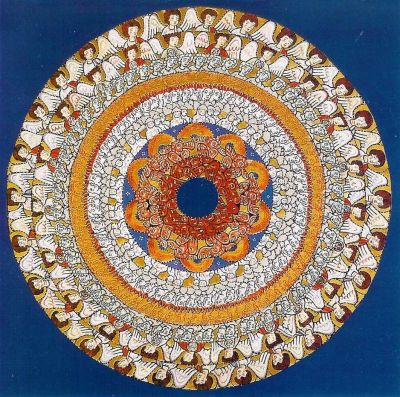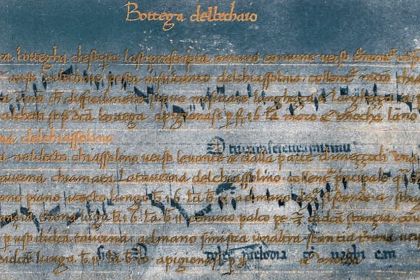Choir
Europe worshiped this 12th-century prophet for her visions rather than her music talent

Illumination of Choirs of Angels from the Liber Scivias by Hildegard von
Bingen
Hildegard von Bingen—German abbess and visionary mystic—was one of the most enigmatic personalities of the Middle Ages. The greatest female author of the period whose works were actually preserved, she wrote on topics ranging from theology to botany with amazing colorful accompanying illustrations. As a composer and poet, she wrote incredibly beautiful and advanced songs for her time period.
Hildegard spent much of her life in a hilltop monastery in Rhineland; there she acquired the name Sibyl of the Rhine for her prophetic visions and received many requests for her guidance. The correspondence between Hildegard and the heads of the clergy, state, and prominent members of nobility seeking her wisdom consists of over 300 letters, making it the most extensive collection of documents of that time.
Hildegard von Bingen was born in 1098 into a family of free nobles in the service of the counts of Sponheim, close relatives of the Hohenstaufen emperors. At 15, she began wearing the Benedictine habit and pursuing a religious life at Disibodenberg cloister.
Having experienced visions since she was a child, at age 43 she consulted her confessor, who in turn reported the matter to the archbishop of Mainz. A committee of theologians subsequently confirmed the authenticity of Hildegard’s visions, and a monk was appointed to help her record them in writing.
Hildegard receiving a vision and dictating to her secretary Volmar:


She spent more than ten years recording these visions in The Liber Scivias (Know the Way), at the heart of which is the inseparable oneness of the Universe (macrocosm) and man (microcosm). Although the original manuscript was lost in the chaos of World War II, an exact copy of it had been carefully made by nuns from the same cloister between 1927 and 1933.
Hildegard wrote three volumes of visionary theology, as well as two volumes of material on natural medicine and healing. She also, for her own amusement, contrived alternative alphabet, calling it Lingua Ignota, with which she invented new words for her poetry and lyrics.
The Cycle of the Seasons from the Liber Divinorum Operum by Hildegard of Bingen:


Hildegard's interest in composition developed shortly after her enclosure as a Benedictine oblate, where she learned to play the psaltery and harp. In fact, she allegedly remains the first composer in history whose biography is somewhat known.
Approximately 70 of Hildegard's compositions have survived, making it one of the largest repertoires among medieval composers. Like most music of her day, she worked with the form of the monophonic song designed for instrumental accompaniment with a tonic pedal point.
God, Cosmos, and Humanity from the Liber Scivias:


Hildegard died in 1179 in the monastery she had founded at Rupertsberg, near Bingen. Though she was known throughout medieval Europe as a stateswoman and a seer, there is no evidence that her music was ever heard outside her own convent.
Now there are hundreds of recordings of her music, though the most authentic interpretation of Hildegard von Bingen's complete works belongs to the music ensemble Sequentia. The collection consists of seven albums released between 1985 and 2013.
Listen to O vis aeternitatis performed by Sequentia:
The earliest biographer of Hildegard von Bingen proclaimed her a saint, reporting that miracles had been witnessed both during her life and at her tomb. However, she was not formally canonized until 2012, when Pope Benedict XVI declared her to be a saint and Doctor of the Church.










